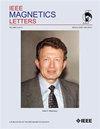用于经颅磁刺激的重叠设计线圈的研制
IF 1.1
4区 物理与天体物理
Q4 ENGINEERING, ELECTRICAL & ELECTRONIC
引用次数: 0
摘要
经颅磁刺激(TMS)是一种无创的神经调控技术,用于治疗各种神经疾病,包括严重抑郁症。用于刺激皮层下结构的脑深部TMS线圈的开发将TMS的使用扩展到刺激皮层浅部目标之外。脑深部刺激可能对帕金森病、创伤后应激障碍和轻度创伤性脑损伤等神经系统疾病有有益影响。先前的研究表明,小脑在行为和运动规划中发挥着非常重要的作用。为了刺激人脑的特定区域,我们需要一个具有精确聚焦能力的TMS线圈,因为TMS线圈的材料、设计和位置在调节线圈的聚焦功率方面起着重要作用。因此,我们研究了在不同位置放置两种不同的新线圈设计对额叶和小脑的刺激。开发了一种罕见的由Litz线制成的TMS线圈设计,以增强大脑中的激励聚焦,并与传统的八字形(FOE)线圈和双锥形线圈进行了比较。有限元模拟工具ANSYS Maxwell 3-D已用于模拟和比较人脑模型内部感应的磁场和电场。线圈研究如下:FOE线圈、重叠铜线圈和Litz线重叠线圈。随后进行了实验验证,结果与模拟结果非常一致。本文章由计算机程序翻译,如有差异,请以英文原文为准。
Development of Overlapped Designed Coils for Transcranial Magnetic Stimulations
Transcranial magnetic stimulation (TMS) is a noninvasive neuromodulation technique that is used to treat a variety of neurological disorders, including major depression. The development of the deep brain TMS coil for stimulating subcortical structures expands the use of TMS beyond the stimulation of superficial cortical targets. Deep brain stimulation may have beneficial effects on neurological disorders such as Parkinson's disease, post-traumatic stress disorder, and mild traumatic brain injury. Previous studies have shown that the cerebellum plays a very big role in behavior and motor planning. To stimulate the specific areas of the human brain, we require a TMS coil with precise focal abilities because the material, design, and position of a TMS coil play a significant role in adjusting the coil's focusing power. Therefore, we studied stimulation of the frontal brain and cerebellum with two different new coil designs positioned on different locations. A rare design of the TMS coil made with Litz wire was developed to enhance excitation focality in the brain and was compared with a traditional figure-of-eight (FOE) coil and double-cone coil. The finite-element simulation tool ANSYS Maxwell 3-D has been used to simulate and compare the magnetic field and electric field induced inside the model of the human brain. The coil studies are as follows: a FOE coil, an overlapped copper coil, and a Litz wire overlapped coil. This was followed by experimental validation which shows great agreement with the simulation results.
求助全文
通过发布文献求助,成功后即可免费获取论文全文。
去求助
来源期刊

IEEE Magnetics Letters
PHYSICS, APPLIED-
CiteScore
2.40
自引率
0.00%
发文量
37
期刊介绍:
IEEE Magnetics Letters is a peer-reviewed, archival journal covering the physics and engineering of magnetism, magnetic materials, applied magnetics, design and application of magnetic devices, bio-magnetics, magneto-electronics, and spin electronics. IEEE Magnetics Letters publishes short, scholarly articles of substantial current interest.
IEEE Magnetics Letters is a hybrid Open Access (OA) journal. For a fee, authors have the option making their articles freely available to all, including non-subscribers. OA articles are identified as Open Access.
 求助内容:
求助内容: 应助结果提醒方式:
应助结果提醒方式:


